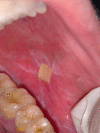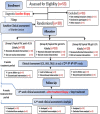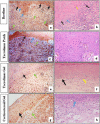Evaluation of muco-adhesive tacrolimus patch on caspase-3 induced apoptosis in oral lichen planus: a randomized clinical trial
- PMID: 36788511
- PMCID: PMC9930326
- DOI: 10.1186/s12903-023-02803-8
Evaluation of muco-adhesive tacrolimus patch on caspase-3 induced apoptosis in oral lichen planus: a randomized clinical trial
Abstract
Background: The study compared the clinical effectiveness of topical Tacrolimus (TAC) in patches or gel with Triamcinolone acetonide (TRI) gel for erosive/atrophic oral lichen planus (OLP) and investigated the influence of these therapies on Caspase-3 expression as a marker of apoptosis.
Methods: Thirty patients were randomly assigned into three equal groups to receive either topical TAC 0.1% patch twice daily, topical TAC 0.1% gel, or topical TRI 0.1% gel four times daily for 8 weeks. Each patient's clinical score (CS), visual analogue scale (VAS), and total atrophic area (TAA) of the marker lesion were measured at baseline, 2, 4, and 8 weeks of treatment, as well as after 4 weeks of treatment free period. Caspase-3 expression and lymphocytic counts (LC) were assessed in pre- and post-treatment biopsied stained sections.
Results: TAC patch resulted in a higher reduction in CS [- 14.00 (15.54%)] and VAS [- 70.21 (15.82%)] followed by TAC gel then TRI gel within the first two weeks. The reduction in VAS and TAA were significantly higher in TAC groups compared to TRI gel, although the difference between TAC treatment was not significant and this was observed throughout the treatment and follow-up periods. Caspase-3 expression increased in connective tissue in all groups. It decreased significantly within the epithelium in both TAC groups but increased in TRI gel. (LC) were significantly lowered with the TAC patch compared to other groups. The percentage change in Caspase-3 epithelial expression was significantly correlated to the CS, TAA, and LC.
Conclusion: Both TAC patch and gel significantly decreased pain and lesion size than TRI gel, with a significant reduction in Caspase-3 expression within the epithelium in comparison to the increase seen with TRI gel. The study protocol was registered at www.
Clinicaltrials: gov (NCT05139667) on 01/12/2021.
Keywords: Apoptotic keratinocytes; Caspase-3; Oral lichen planus; Tacrolimus; Triamcinolone acetonide.
© 2023. The Author(s).
Conflict of interest statement
The authors declare that they have no conflict of interest.
Figures




Similar articles
-
Topical tacrolimus, triamcinolone acetonide, and placebo in oral lichen planus: a pilot randomized controlled trial.Oral Dis. 2017 Jul;23(5):660-668. doi: 10.1111/odi.12653. Epub 2017 Mar 31. Oral Dis. 2017. PMID: 28168769 Clinical Trial.
-
Topical pimecrolimus effect on Fas inducing apoptosis in oral lichen planus: a clinical immunohistochemical study.J Oral Pathol Med. 2012 Apr;41(4):315-21. doi: 10.1111/j.1600-0714.2011.01099.x. Epub 2011 Nov 16. J Oral Pathol Med. 2012. PMID: 22085391
-
Topical pimecrolimus versus betamethasone for oral lichen planus: a randomized clinical trial.Clin Oral Investig. 2019 Feb;23(2):947-956. doi: 10.1007/s00784-018-2519-6. Epub 2018 Jun 16. Clin Oral Investig. 2019. PMID: 29909565 Clinical Trial.
-
Interventions for treating oral lichen planus: corticosteroid therapies.Cochrane Database Syst Rev. 2020 Feb 28;2(2):CD001168. doi: 10.1002/14651858.CD001168.pub3. Cochrane Database Syst Rev. 2020. PMID: 32108333 Free PMC article.
-
Oral lichen planus: comparative efficacy and treatment costs-a systematic review.BMC Oral Health. 2022 May 6;22(1):161. doi: 10.1186/s12903-022-02168-4. BMC Oral Health. 2022. PMID: 35524296 Free PMC article.
Cited by
-
What can we learn from treatments of oral lichen planus?Front Cell Infect Microbiol. 2024 Feb 15;14:1279220. doi: 10.3389/fcimb.2024.1279220. eCollection 2024. Front Cell Infect Microbiol. 2024. PMID: 38426013 Free PMC article. Review.
-
Integrative Approaches for the Diagnosis and Management of Erosive Oral Lichen Planus.Diagnostics (Basel). 2024 Mar 26;14(7):692. doi: 10.3390/diagnostics14070692. Diagnostics (Basel). 2024. PMID: 38611605 Free PMC article. Review.
-
Lichen planus-the role of age and gender in clinical appearance and treatment : A narrative review.Wien Med Wochenschr. 2024 Nov 12. doi: 10.1007/s10354-024-01057-5. Online ahead of print. Wien Med Wochenschr. 2024. PMID: 39531121 Review. English.
-
A Decadal Bibliometric Analysis on the Therapeutic Strategies in Oral Lichen Planus.Health Sci Rep. 2025 Jan 29;8(2):e70403. doi: 10.1002/hsr2.70403. eCollection 2025 Feb. Health Sci Rep. 2025. PMID: 39897464 Free PMC article.
-
Janus LAAM-loaded electrospun fibrous buccal films for treating opioid use disorder.Biomaterials. 2025 Jun;317:123041. doi: 10.1016/j.biomaterials.2024.123041. Epub 2024 Dec 22. Biomaterials. 2025. PMID: 39753084
References
Publication types
MeSH terms
Substances
Associated data
LinkOut - more resources
Full Text Sources
Medical
Research Materials

